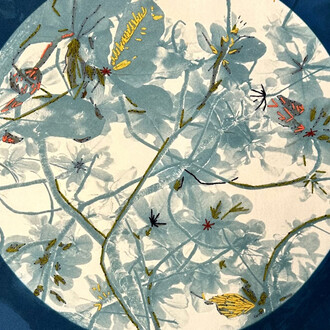Eric Firestone Gallery is pleased to announce To the north star, a survey exhibition of the work of Joe Overstreet (1933–2019). Overstreet was an artist and activist who pushed the boundaries of painting through decades of experimentation, reflecting on the Black experience within his abstractions. He is the subject of a recent survey exhibition organized by the Menil Collection, Houston, and curated by Natalie Dupêcher, which is traveling to the Mississippi Museum of Art and opening November 1.
The gallery exhibition will include work from across the artist’s career and technical approaches. These include the shaped canvas paintings of the 1960s that reflect the Civil Rights Movement, and the Flight patterns of the early 1970s—unstretched canvases tethered with ropes to the wall, ceiling, and floor. Finally, paintings of the 1990s will be on view: stretched canvases with ropes adorning their surfaces. Works on paper from throughout the artist’s career will accompany the canvases.
This survey exhibition reflects significant new scholarship, allowing for a fuller understanding of the artist’s career, his own statements, and the socio-political milieu that informed his aesthetics and community activism. Through this continued re-evaluation we recognize how deeply Overstreet’s abstractions were embedded with personal and political content. This scholarship is compiled in the recent publication Joe Overstreet, Taking flight by Natalie Dupêcher, with contributions by Darby English, Richard Hylton, Corrine Jennings, Rebecca Rabinow, Ishmael Reed, Abbe Schriber and Jacqueline Siegel, published by the Menil Collection, Houston and distributed by Yale University Press, 2025. It will be celebrated with a book event at the gallery on November 5 at 5 PM, with readings by Dupêcher and Reed.
Notably, the gallery’s exhibition will include Flight pattern paintings recently re-discovered in the artist’s studio. These paintings, known from historic photographs, were previously assumed to be lost and will be on view for the first time in over five decades.
A desire to “open up space,” in all senses, infuses Overstreet’s work. In 1967, Overstreet began to create shaped canvas constructions, building by hand intricate, angular stretchers. For the first time since a 1969 exhibition at the Brooklyn Museum, the major shaped painting Ungawa - Black power (1968), from this body of work, will be on view. “I felt abstract expressionism had pushed painting all the way to the boundaries,” he later recalled, “and there was no place to go except outside the framework.” With the shapes, patterns, and titles, he looked to non-Western sources, like Aztec, Benin, and Egyptian art. Overstreet placed this work in the context of a search for freedom from oppression, stigma, and political and economic repression.
With his Flight pattern paintings, which turn two-dimensional canvases into three-dimensional activations of the environment, Overstreet was concerned with a spatial transformation. As he wrote in 1970, an unstretched canvas could be rolled up and easily transported, but upon unrolling, it became a “scroll canvas” suspended on ropes that could “expand forever.” These ropes could metaphorically “run to the farthest points of the universe.” The canvas became sculpture and space. Considering the idea of the North Star as a beacon towards freedom for enslaved people inspired the artist to look upward, to point his paintings towards the ceiling, and to use ropes.
The desire to open up space continued outside of the artist’s studio; Overstreet was committed to his community of Black artists. Overstreet, and his wife Corrine Jennings, recognized that many Black artists faced a lack of space to work, experiment, and present their art. They often needed both resources and institutional support. To that end, Jennings and Overstreet created Kenkeleba House, which began as an interdisciplinary project space in a Bowery loft, and grew into a six-story East Village building. In one of the many “sweat-equity” projects realized in 1970s New York, Overstreet, Jennings, and their associates transformed a deteriorating building on East Second Street into an exhibition and artist studio complex—which has since presented thousands of artists of color, and remains active today.












